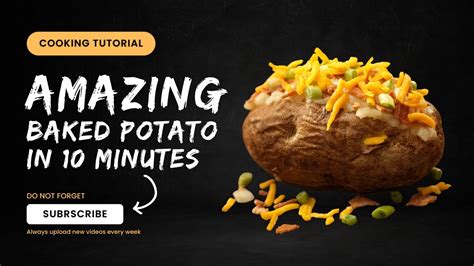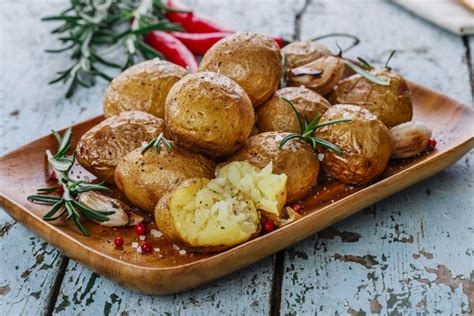
A kitchen shortcut promising fully baked potatoes in as little as 15 minutes is making waves online, potentially elevating home cooks to chef-level status and impressing friends with its speed and simplicity. This method drastically reduces the traditional baking time, offering a convenient solution for quick meals and side dishes.
The conventional method of baking potatoes, typically requiring an hour or more in the oven, has long been a deterrent for those seeking a fast and easy dinner option. This new technique, however, challenges that notion by employing a combination of microwaving and oven baking to achieve a fluffy interior and crispy skin in a fraction of the time. According to the Yahoo! Lifestyle article, this “hack” is particularly appealing to busy individuals and families looking to streamline their meal preparation without sacrificing the quality and taste of a classic baked potato.
The technique involves initially microwaving the potatoes for approximately 5 to 8 minutes, depending on their size, followed by a brief stint in a preheated oven at a high temperature (around 450°F or 232°C) for about 10 to 15 minutes. This dual-stage process ensures that the potato cooks thoroughly while achieving the desired textural contrast. The microwave softens the potato from the inside out, while the oven crisps the skin, delivering a result comparable to traditional baking but with significantly reduced cooking time.
“The secret is to microwave the potato first to soften the inside,” the article explains, “then finish it in a hot oven to get that crispy skin we all love.” This simple yet effective approach is gaining traction among home cooks eager to find time-saving alternatives in the kitchen.
The appeal of this accelerated baking method extends beyond mere convenience. It also addresses the common concern of energy consumption. By drastically reducing oven time, the technique can potentially lower energy bills, making it an attractive option for environmentally conscious consumers. Moreover, the method is versatile and can be adapted to various potato types, from russets to Yukon golds, allowing for culinary experimentation and personalized flavor profiles.
The rise in popularity of this baking “hack” underscores a broader trend in modern cooking: the pursuit of efficiency without compromising on taste and quality. As consumers increasingly seek convenient and time-saving solutions, innovative techniques like this one are poised to reshape the way we approach traditional recipes.
This method not only slashes cooking time but also opens up possibilities for weeknight meals that were previously considered too time-consuming. Imagine coming home from work and enjoying a perfectly baked potato, loaded with your favorite toppings, in under 30 minutes. This once-a-week treat can now become a regular staple, adding variety and satisfaction to your diet.
The process begins with selecting your potatoes. Russet potatoes are a popular choice due to their high starch content, which contributes to their fluffy texture when baked. However, other varieties like Yukon Gold or red potatoes can also be used, each offering a slightly different flavor and texture.
Before microwaving, it’s crucial to wash the potatoes thoroughly to remove any dirt or debris. Then, using a fork, pierce the potatoes several times. This step is essential to allow steam to escape during microwaving, preventing the potatoes from exploding. Microwaving potatoes without piercing them can create a dangerous buildup of pressure, leading to a messy and potentially hazardous situation.
The microwaving time will vary depending on the size and quantity of the potatoes. As a general guideline, a medium-sized potato will typically require 5 to 8 minutes on high power. For larger potatoes or multiple potatoes, you may need to increase the microwaving time accordingly. It’s best to check the potatoes for doneness after the initial microwaving period. They should be slightly soft to the touch but not fully cooked through.
Once the potatoes are microwaved, preheat your oven to 450°F (232°C). While the oven is heating, prepare the potatoes for baking. Lightly coat the potatoes with olive oil or another cooking oil of your choice. This will help to create a crispy and flavorful skin. Season the potatoes with salt, pepper, and any other desired spices. Garlic powder, onion powder, paprika, and herbs like rosemary or thyme can add extra layers of flavor.
Place the oiled and seasoned potatoes directly on the oven rack or on a baking sheet. Baking them directly on the rack allows for better air circulation, resulting in a crispier skin. Bake for 10 to 15 minutes, or until the skin is golden brown and crispy.
To check for doneness, insert a fork or knife into the center of the potato. If it goes in easily, the potato is fully cooked. Remove the potatoes from the oven and let them cool slightly before handling.
Once the potatoes are cool enough to handle, slice them open and fluff the insides with a fork. Now, the fun part begins: adding your favorite toppings.
The possibilities for toppings are endless. Classic options include butter, sour cream, shredded cheese, bacon bits, chives, and scallions. For a healthier twist, try topping your baked potato with Greek yogurt, salsa, avocado, or steamed vegetables. You can also create more elaborate baked potato meals by adding chili, pulled pork, or roasted chicken.
The key to a perfect baked potato is to ensure that it is cooked thoroughly but not overcooked. Overcooked potatoes can become dry and mushy, while undercooked potatoes will be hard and starchy. By following the microwaving and baking guidelines, you can achieve a perfectly cooked baked potato every time.
Furthermore, the versatility of baked potatoes makes them an ideal canvas for culinary creativity. Experiment with different flavor combinations and toppings to create unique and satisfying meals. Consider exploring regional variations of baked potatoes, such as the loaded baked potatoes popular in the American South, which often include barbecue meats, coleslaw, and other regional specialties.
The “Baked Potato Hack” not only offers a significant time-saving advantage but also a sustainable method for reducing energy consumption. By minimizing the oven time, you can lower your electricity bill and reduce your carbon footprint. This is particularly relevant in today’s world, where consumers are increasingly aware of the environmental impact of their food choices.
In conclusion, the “Baked Potato Hack” is a game-changer for home cooks seeking a quick, easy, and delicious way to enjoy baked potatoes. By combining the efficiency of microwaving with the crisping power of oven baking, this technique delivers perfectly cooked baked potatoes in a fraction of the time. Embrace this innovative method and elevate your culinary skills to chef-level status, impressing your friends and family with your newfound potato prowess.
Beyond the basic method, several variations and tips can further enhance the flavor and texture of your baked potatoes. Consider using different types of oil for coating the potatoes, such as avocado oil or coconut oil, which can impart subtle flavor nuances. Experiment with different seasonings, such as smoked paprika, chili powder, or Italian herbs, to create unique flavor profiles.
Another tip is to score the potatoes lengthwise before baking. This helps to release steam and allows the insides to become even fluffier. You can also try poking the potatoes with a fork several times during the baking process to ensure even cooking.
For those who prefer a softer skin, wrapping the potatoes in foil before baking can help to retain moisture. However, keep in mind that this will result in a less crispy skin.
The “Baked Potato Hack” is also a great way to use up leftover ingredients. Transform leftover chili, pulled pork, or roasted vegetables into delicious baked potato toppings. This is a sustainable and cost-effective way to reduce food waste and create satisfying meals.
Moreover, the technique can be adapted to other root vegetables, such as sweet potatoes and yams. Sweet potatoes, in particular, benefit from the same microwaving and baking process, resulting in a tender interior and caramelized skin. Experiment with different seasonings and toppings to create unique sweet potato dishes.
The possibilities are endless, and the “Baked Potato Hack” is a versatile tool that can be incorporated into a wide range of culinary creations. From simple weeknight dinners to elaborate gourmet meals, this technique offers a convenient and efficient way to enjoy the classic comfort food that is the baked potato.
The recent surge in popularity of the “Baked Potato Hack” highlights a growing trend in the culinary world: the embrace of innovative techniques that streamline cooking processes without sacrificing quality. As consumers become increasingly time-conscious, they are actively seeking methods that allow them to enjoy delicious and nutritious meals in a fraction of the time.
This trend is further fueled by the proliferation of online cooking resources, such as blogs, videos, and social media platforms, which provide a wealth of information and inspiration for home cooks. These resources empower individuals to experiment with new techniques and ingredients, fostering a culture of culinary creativity and innovation.
The “Baked Potato Hack” is a prime example of this trend, demonstrating how a simple yet effective technique can transform a classic dish into a quick and easy weeknight meal. Its popularity underscores the growing demand for convenient and time-saving cooking solutions.
Furthermore, the technique aligns with the increasing focus on sustainability and reducing food waste. By minimizing oven time and encouraging the use of leftover ingredients, the “Baked Potato Hack” promotes environmentally conscious cooking practices.
In conclusion, the “Baked Potato Hack” is more than just a cooking shortcut; it is a reflection of broader trends in the culinary world, including the pursuit of efficiency, the embrace of innovation, and the growing emphasis on sustainability. As consumers continue to seek convenient and responsible ways to prepare meals, techniques like this one are poised to shape the future of cooking.
The “Baked Potato Hack” is a testament to the power of culinary ingenuity. It demonstrates how a simple modification to a traditional cooking method can yield significant benefits, including reduced cooking time, lower energy consumption, and enhanced flavor.
The technique’s success lies in its ability to leverage the strengths of both microwaving and oven baking. Microwaving efficiently softens the potato from the inside out, while oven baking provides the crispy skin and caramelized flavor that are hallmarks of a perfectly baked potato.
By combining these two cooking methods, the “Baked Potato Hack” achieves a result that is superior to either method alone. Microwaving alone can result in a mushy and unappetizing potato, while oven baking alone can be time-consuming and energy-intensive.
The “Baked Potato Hack” strikes the perfect balance, delivering a delicious and satisfying baked potato in a fraction of the time. Its simplicity and effectiveness make it an accessible technique for cooks of all skill levels.
Whether you are a seasoned chef or a novice home cook, the “Baked Potato Hack” is a valuable tool to have in your culinary arsenal. It is a testament to the fact that sometimes, the simplest solutions are the most effective.
The “Baked Potato Hack” is not just about saving time; it is also about enhancing the overall cooking experience. By simplifying the process of baking potatoes, it frees up time and energy for other culinary endeavors.
Instead of spending an hour or more waiting for potatoes to bake, you can use that time to prepare other dishes, experiment with new recipes, or simply relax and enjoy the company of friends and family.
The “Baked Potato Hack” can also make cooking more enjoyable and less stressful. By eliminating the long wait time associated with traditional baking, it reduces the likelihood of last-minute mealtime panics.
With the “Baked Potato Hack,” you can confidently prepare baked potatoes knowing that they will be ready in a timely manner. This can help to create a more relaxed and enjoyable cooking environment.
Moreover, the “Baked Potato Hack” can inspire culinary creativity. By freeing up time and energy, it allows you to explore new flavor combinations and toppings, transforming the humble baked potato into a culinary masterpiece.
The “Baked Potato Hack” is not just about saving time; it is about enhancing the entire cooking experience, making it more enjoyable, less stressful, and more conducive to culinary creativity.
The key to mastering the “Baked Potato Hack” lies in understanding the nuances of each cooking method. While microwaving is efficient for softening the potato’s interior, it is crucial to avoid overcooking, which can result in a mushy texture.
The ideal microwaving time will vary depending on the size and quantity of the potatoes. It is best to err on the side of undercooking, as the potatoes will continue to cook in the oven.
When baking the potatoes, it is important to preheat the oven to the correct temperature. A high temperature is essential for achieving a crispy skin and caramelized flavor.
The baking time will also vary depending on the size and quantity of the potatoes. It is best to check for doneness by inserting a fork or knife into the center of the potato. If it goes in easily, the potato is fully cooked.
Another important factor to consider is the type of potato. Russet potatoes are generally preferred for baking due to their high starch content, which contributes to their fluffy texture. However, other varieties, such as Yukon Gold and red potatoes, can also be used, each offering a slightly different flavor and texture.
Experimenting with different types of potatoes can help you to discover your personal preference. The “Baked Potato Hack” is a versatile technique that can be adapted to a wide range of potato varieties.
By understanding the nuances of each cooking method and experimenting with different types of potatoes, you can master the “Baked Potato Hack” and consistently produce perfectly cooked baked potatoes.
The “Baked Potato Hack” is a valuable addition to any home cook’s repertoire. It is a simple, efficient, and versatile technique that can transform a classic dish into a quick and easy weeknight meal.
By combining the efficiency of microwaving with the crisping power of oven baking, the “Baked Potato Hack” delivers perfectly cooked baked potatoes in a fraction of the time. It is a testament to the power of culinary ingenuity and a reflection of broader trends in the culinary world.
As consumers continue to seek convenient and responsible ways to prepare meals, techniques like the “Baked Potato Hack” are poised to shape the future of cooking. Embrace this innovative method and elevate your culinary skills to chef-level status, impressing your friends and family with your newfound potato prowess.
Frequently Asked Questions (FAQ):
-
How does this “Baked Potato Hack” actually work to bake potatoes faster?
The “Baked Potato Hack” combines microwaving and oven baking. The microwave softens the potato internally in about 5-8 minutes, while a short stint in a hot oven (450°F/232°C) crisps the skin in 10-15 minutes. As the Yahoo! Lifestyle article explains, “The secret is to microwave the potato first to soften the inside, then finish it in a hot oven to get that crispy skin we all love.”
-
What kind of potatoes work best with this method?
Russet potatoes are generally recommended due to their high starch content, resulting in a fluffy texture. However, Yukon Gold or red potatoes can also be used, offering different flavors and textures. The method is adaptable to various potato types.
-
Is it safe to microwave potatoes? What precautions should I take?
Yes, it is safe to microwave potatoes. It’s essential to pierce the potatoes several times with a fork before microwaving to allow steam to escape. Failure to do so can cause the potatoes to explode due to the buildup of internal pressure.
-
Can this method really save energy compared to traditional baking?
Yes, this method can save energy. By significantly reducing the oven time, the overall energy consumption is lower compared to baking potatoes for an hour or more. This makes it a more environmentally friendly cooking option.
-
What are some creative topping ideas to enhance the flavor of these quickly baked potatoes?
The options are vast! Classic toppings include butter, sour cream, cheese, bacon, and chives. Healthier options are Greek yogurt, salsa, avocado, or steamed vegetables. Leftover chili, pulled pork, or roasted chicken also make excellent toppings for a complete meal.



![[Restaurant Name] Returns! Iconic Chain Revives After 30-Year Absence](https://generasitekno.com/wp-content/uploads/2025/06/unnamed-file-924-150x150.jpg)





